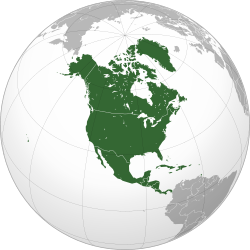Novopangaea
Novopangaea or Novopangea (Greco-Latin for "New Pangaea") is a possible future supercontinent postulated by Roy Livermore (now at the University of Cambridge) in the late 1990s. It assumes closure of the Pacific,[1] docking of Australia with East Asia, and northward motion of Antarctica.
Alternative scenarios
Paleogeologist Ronald Blakey has described the next 15 to 100 million years of tectonic development as fairly settled and predictable[2] but no supercontinent will form in that time frame. Beyond that, he cautions that the geologic record is full of unexpected shifts in tectonic activity that make further projections "very, very speculative".[2] In addition to Novopangaea, two other hypothetical supercontinents—"Amasia" and Christopher Scotese's "Pangaea Ultima"—were illustrated in an October 2007 New Scientist article.[3]
References
- Wilkins, Alasdair. "A Geological History of Supercontinents on Planet Earth" at io9. 27 Jan 2011. Accessed 22 July 2014.
- Manaugh, Geoff & al. "What Did the Continents Look Like Millions of Years Ago?" in The Atlantic online. 23 Sept 2013. Accessed 22 July 2014.
- Williams, Caroline; Nield, Ted (20 October 2007). "Pangaea, the comeback". New Scientist. Archived from the original on 13 April 2008. Retrieved 4 August 2016.
Further reading
- Nield, Ted, Supercontinent: Ten Billion Years in the Life of Our Planet, Harvard University Press, 2009, ISBN 978-0674032453
.svg.png)
.svg.png)
.svg.png)
.svg.png)


.svg.png)
_political.svg.png)
.svg.png)
.svg.png)
.svg.png)